Experience with COTS components on ADPMS unit (PROBA satellites)
- Posted by Steven De Cuyper
- On December 3, 2019
- 0
Agenda
1 Company Introduction
2 ADPMS Introduction
3 Why COTS?
4 Examples
5 Conclusion
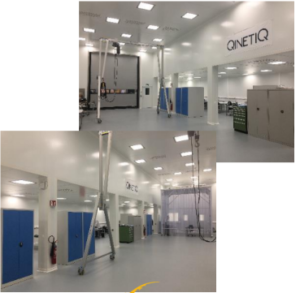 Company Introduction
Company Introduction
- Founded in 1969 as product developer
- Space activities started in 1983
- Delivered 100+ systems and sub-systems for manned space stations, satellites and interplanetary missions
- Acquired by the QinetiQ group (UK) in 2005
- 170 highly educated specialists employed
- 2 sites in Belgium
- 450m2 cleanroom
QinetiQ Space Ground Station
- Located in Belgium, Redu
- ESA satellite ground station
- Jointly operated with SES Astra
QinetiQ Space
- Located in Belgium, Kruibeke
- Offices: 3.742 m2, Warehouses: 1.200 m2
- 2 Class 100.000 cleanrooms
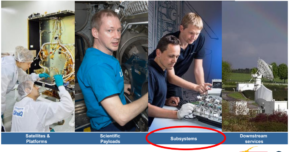
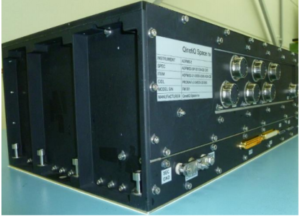 ADPMS Introduction
ADPMS Introduction
- ADPMS : Advanced Data and Power Management System
- Dual lane computer and power system
- Modular digital boards
- Intended for platform computer
- Onboard computer for Proba satellites
- Design started in 2000
- Flight heritage on Proba-2 and Proba-V (16 combined years in orbit)
- Flight units ready for Proba-3
- Spin-off used on IXV
- Parts Usage
- General class 3 level parts
- About 20 different types of commercial COTS parts used on a total almost 300 parts
- Design predates the ECSS-Q-ST-60-13C
Why COTS?
- Because of functional reasons (No suitable FM equivalent available)
- However market and availability evolves
- Several components could now be replaced by MIL / ECSS / Hi-rel parts
- But, unless replacement is size/function compatible, risk of change is considered too high
- Very dense PCBs prevent updating without complete redesign
- Loss of flight heritage / qualification
- excellent performance of most COTS parts in space
- However market and availability evolves
- NOT because of cost reasons
- Component parts cost is lower however
- Upscreening costs
- Parts approval flow (repeated for each project)
- Radiation testing when applicable
- Solder qualification
- (relifing)
- Component parts cost is lower however
-
- Difficult to assess total cost at start of project
- Accumulated cost of PAD discussions and extra tests over consecutive projects
- Obsolescence, manufacturer changes or batch variability (no long term assurance)
- Difficult to assess total cost at start of project
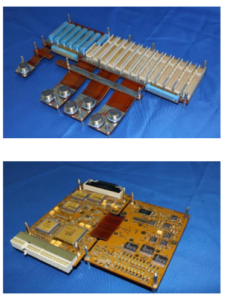 Design concept
Design concept
- cPCI compliant modular boards and backplane with rear-IO
- Multiple types of cPCI connectors
- cPCI compliant modular boards and backplane with rear-IO
- PCB space constraints
- Decoupling of CCGA /MCGA devices
- 0402 ceramic capacitors
- Large value / small size ceramics
- Qualified parts too large to accommodate
- SOT23 plastic package dual schottky diode
- Decoupling of CCGA /MCGA devices
- Functionality and performance
- Memories required for LEON processor
- Commercial SRAM and FLASH
- Low power analog housekeeping
- ADC, OPAMP and instrumentation amplifier
- Memories required for LEON processor
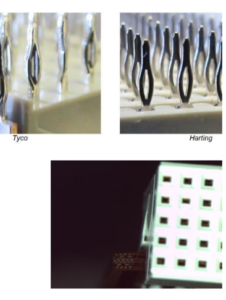 Design concept : cPCI connectors
Design concept : cPCI connectors
- Part selection and Qualification
- Initially parts from Tyco were selected with Sn/Pb leads
- For each FM lot a press-fit qualification campaign was required
- Extensive Lot acceptance testing, structural analysis performed
- Lessons learned
- Standard PCB manufacturing with hot-oil reflow finish not ideal for press-fit mounting due to tolerance restrictions.
- Due to obsolescence change required to other manufacturer (Harting)
- Different tolerances and small dimension differences caused damaged connectors and pins
- Same type of connector but internal construction is significantly different between manufacturers.
- Current status
- cPCI equivalent connectors for space are available but limited choice and no reliable intermateability with other brands can be warranted.
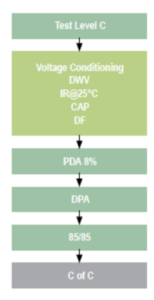 PCB space constraints : Ceramic capacitors
PCB space constraints : Ceramic capacitors
- Part selection and upscreening
- Commercial “Hi-rel” 0402, 0805 and 1206 caps from Kemet
- Procured with traceability from authorized distributor
- Manufacturer test level “C”
- SnPb finish
- Commercial “Hi-rel” 0402, 0805 and 1206 caps from Kemet
- Lessons learned
- Solder qualification and operational performance successful
- Lifetime issues, solderability decreases
- Solderability failed in reusing previous flight lot, new procurement required
- Sourcing new SnPb COTS parts difficult with increased lead time (non standard product)
- Current status
- 0402 size capacitors are now available from European space-qualified manufacturers
- High lead time and considerable higher cost than MIL CDR types
- Used in new designs requiring class 3 or better.
- 0402 size capacitors are now available from European space-qualified manufacturers
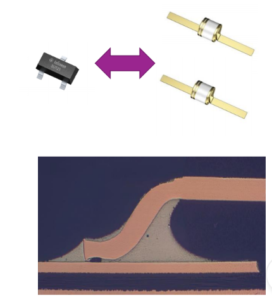 PCB space constraints : SOT23 plastic package dual schottky diode
PCB space constraints : SOT23 plastic package dual schottky diode
- Part selection
- Multiple small signal schottky diodes required on small space
- Space qualified single diodes available but FM package too large
- Initial part from ON-semi selected
- Lessons learned
- Obsolete ON-Semi Flight batch failed 7-year relifing
- Same BAS40-04 component from Infineon selected as replacement
- Solder qualification required for all new batches of plastic parts
- No issues for the older On-Semi part
- Initial solder qualification of Infineon part failed due to difference in lead
- Obsolescence and differences between commercial parts resulted in an unexpected cost and delay.
- Obsolete ON-Semi Flight batch failed 7-year relifing
- Current status
- Still a need for small diode packages
- New designs with no COTS use more PCB area for same configuration
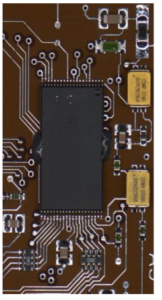 Functionality and performance : Memories
Functionality and performance : Memories
- Part selection and upscreening
- Components were selected because some radiation data was already available
- COTS memories have a short market lifetime. Large number was purchased. FM assembly uses only a few but quantities for upscreening and testing are significant.
- Solder qualification required on each lot of plastic parts
- Radiation test cost is extensive
- Total dose testing
- Single event latchup testing
- Single event effects testing (SEU, SEFI)
- In some cases proton SEE testing was required (sensitive part)
- Lessons learned
- Combining all test costs the memories become the most expensive parts
- Quick obsolescence and short lifespan of non hermetic plastic parts is a project risk and eventually limits the time a design can be reused.
- Beware of variations in a “single lot” COTS parts
- Current status
- For new projects external qualified devices (e.g. 3D-plus) are preferred
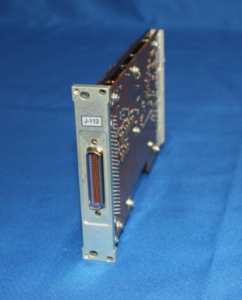 Functionality and performance : Analog Frontend
Functionality and performance : Analog Frontend
- Part selection and upscreening
- Core is a radhard RTAX FPGA
- Power conditioning with radhard parts
- Critical parts for analog acquisition however are all COTS
- Low speed ADC with SPI interface
- Opamp
- Instrumentation amplifier
- Several high precision resistor divider arrays
- Lessons learned
- To date no degradation is notable on the DAM housekeeping telemetry on both the Proba-2 and Proba-V satellites
- No SEFI detected over the years for the ADC
- Current status
- Qualified devices available on the market
Conclusion
- COTS can be successfully used in space
- Risk of obsolescence
- Significant differences between batches and manufacturers
- Upscreening costs per part are very high for small series
COTS comes with a COST
Latest posts by Steven De Cuyper (see all)
- Experience with COTS components on ADPMS unit (PROBA satellites) - December 3, 2019


0 comments on Experience with COTS components on ADPMS unit (PROBA satellites)